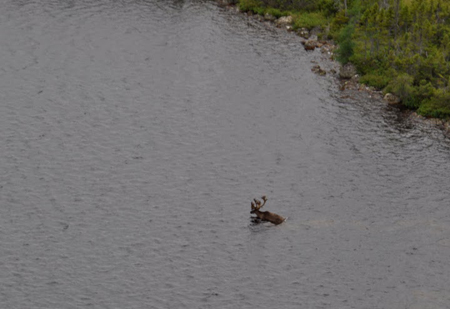Today the public comment period for the Canadian federal government’s woodland caribou recovery strategy ended. Woodland caribou populations have been spiraling downward for decades, prompting concern among environmentalists, Aboriginal communities, and many everyday citizens concerned with the future of our planet.

A lone caribou crosses a river in Labrador.
Credit: Valerie Courtois, Canadian Boreal Initiative
The government actually received so many comments to their draft strategy—14,000 in all—that they need an extra 30 days on top of their initial 30 day window to be able to review them all. This comes just a week after the Canadian Parks and Wilderness Society (CPAWS) submitted 32,000 petition signatures to the government asking for a robust and clear recovery strategy. 32,000 is the most up-to-date estimate of how many woodland caribou exist in the wild today, down from well over 100,000 just decades ago.
If anything, the petition and the astounding number of public comments they received should only further fuel the fire under their feet to come up with a responsible, scientifically-credible strategy for reversing this concerning drop in caribou across Canada. Some of the main concerns with the draft strategy that have been voiced include:
-Recovery plans would only apply to around half of the herds in Canada
-It only requires government to provide herds with a 60% chance of survival; many think the number should be closer to 80%
-In some areas such as the tar sands region of Alberta, recovery techniques would focus more on killing predators like wolves rather than protecting key habitat from development, which is what scientists argue is the most effective strategy; the Pembina Institute recently found that more than 80% of current caribou habitat in the tar sands region is leased for oil and gas development.
-It doesn't provide enough leadership to First Nations, who have lived and coexisted harmoniously with woodland caribou for thousands of years and many of which continue to rely on caribou for subsistence.
In order to provide government with the best available science behind what is truly needed to make an impact, I coauthored a policy paper with the International Boreal Conservation Science Panel and other notable scientists to provide specifics about what caribou need to have a chance at survival. The paper, Keeping Woodland Caribou in the Boreal Forest, can be found here.

Woodland caribou are featured on the Canadian quarter.
Credit: Canadian Mint
A lot is at stake. Not only is an iconic animal, featured on the Canadian quarter, plummeting closer to extinction each decade, but a whole host of other species are directly threatened as a result. Caribou are an indicator species, meaning their health is directly reflective of the overall health of their boreal forest environment. Aboriginal peoples who have relied on caribou for food, clothing, and tools for generations could see this important and spiritual animal disappear before their eyes. And as I mentioned in an earlier post, there are a tremendous number of birds, many of which equally threatened such as the Olive-sided Flycatcher, that share habitat with woodland caribou. Preserving these caribou goes far beyond just the animal itself.
We hope the government takes this opportunity seriously and revises its strategy not based on what it can do minimally without instilling backlash, but based on what gives caribou the best chance at living and thriving for centuries to come.

